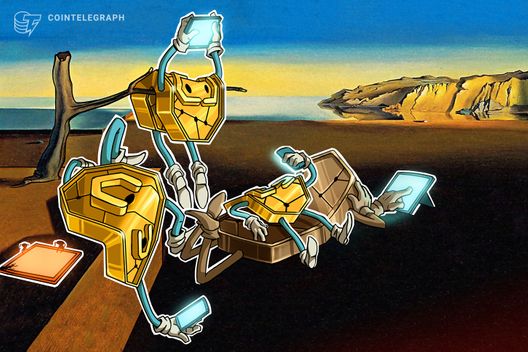What is Bitcoin’s fee-to-reward ratio?
The Bitcoin fee-to-reward ratio represents the proportion of total block rewards from transaction fees paid by users in the Bitcoin network.
Transaction fees allow users to offer compensation to miners to encourage the inclusion of their Bitcoin (BTC) transactions in a block. To increase their profits, miners frequently prioritize transactions with higher fees. However, the fee amount may vary depending on variables, including network congestion and the size of a user’s transaction in bytes.
By resolving challenging mathematical riddles to validate transactions and secure the network, miners play a critical role in the Bitcoin network. Miners receive newly created BTC (block reward, often referred to as block subsidy) and any fees from the transactions they include in the blocks as a reward for their work.

To retain their income, miners increasingly rely on transaction fees as the block subsidy diminishes over time due to halvings. As Bitcoin gets closer to reaching its maximum supply of 21 million coins, this dynamic is anticipated to persist.
Here’s how to calculate the Bitcoin fee-to-reward ratio:

To understand what this ratio indicates, consider three scenarios where the Bitcoin fee-to-reward ratio is greater than 1, equal to 1 and less than 1.
Bitcoin fee-to-reward ratio greater than 1
Consider a scenario in which users transact often, the block reward is 6.25 BTC, and there is a huge demand for block space. In this situation, users are prepared to pay higher fees to validate their transactions more promptly. Let’s assume miners received 7 BTC in transaction fees for the included transactions in the block.

In this case, the fee-to-reward ratio is greater than 1 (1.12), demonstrating that the total miner fees earned are greater than the block reward. When users want their transactions to be confirmed quickly, a situation like this arises since transaction fee bidding is competitive.
Bitcoin fee-to-reward ratio equal to 1
Let’s now explore a case in which the block reward and the total amount of transaction fees miners earn for including transactions in the block are the same. Assume the total fees collected are 6.25 BTC, using the same block reward of 6.25 BTC.

In this case, fees and the block reward contribute equally to the miner’s revenue.
Bitcoin fee-to-reward ratio less than 1
Now imagine that there is less demand for transactions on the network and that users are unwilling to pay high fees to validate their transactions. Assume that miners have received 4 BTC in transaction fees, but the block reward is still 6.25 BTC.

In this case, the fee-to-reward ratio is 0.64, suggesting that the block reward is greater than the sum of transaction fees collected by miners. This might occur when there are fewer transactions in the mempool, lower network congestion or when users aren’t vying as hard to add their transactions to the next block.
The Bitcoin fee-to-reward ratio is significant because it captures the shifting economic incentives present in the network. This ratio is essential to the network’s operation, affecting users, miners, and the general stability and security of the blockchain.
Miner incentives and security
Miners are essential to the security and validity of transactions on the Bitcoin network. They use processing power and resources to mine new blocks to solve challenging mathematical puzzles. Transaction fees and the block reward (newly created BTC) are incentives for miners. Faster confirmation times and greater network security can be achieved by miners prioritizing transactions with significant fees when the fee-to-reward ratio is higher.
Prioritizing transactions
The fee-to-reward ratio becomes very important when there is a lot of network traffic, with many transactions vying for a small amount of block space. Users who want their transactions to be confirmed quickly may probably charge more. Miners are more inclined to include transactions with higher fees in the blocks they mine because of the possibility of increased profits. This guarantees that transactions are completed quickly and aids in controlling network congestion.
Sustainability post-halving
The block reward is halved as part of the Bitcoin protocol roughly every four years. This occurrence is programmed into the protocol. Transaction fees account for more and more of the miner’s income as the block reward declines over time. As the block reward drops, the fee-to-reward ratio helps assess if miners can support their operations exclusively through transaction fees.
Network resilience
The Bitcoin fee-to-reward ratio provides insight into the network’s financial stability. A healthy ratio shows that users are prepared to pay fair transaction fees, supporting the security and continued operation of the network. Consistently low ratios could deter miners, compromising network security and diminishing transaction processing power.
Market sentiment
User behavior and the fee-to-reward ratio can both be indicators of market sentiment. High transaction costs could mean more people are interested in using the Bitcoin network during such times. Low fees, on the other hand, might imply diminished network demand and activity.
Adapting incentives
The fee-to-reward ratio adapts to changing market conditions, technological developments and user preferences. The variables affecting the ratio change, along with the crypto environment, offer insights into the network’s reactivity and flexibility.
The sustainable future of the Bitcoin network rests on the delicate balance between miner incentives, network security and user-friendly transaction costs.
The multidimensional issue of whether a higher Bitcoin fee-to-reward ratio is necessary for the financial viability of the Bitcoin network has sparked discussions within the cryptocurrency industry.
On one hand, supporters contend that stronger short-term incentives for miners to actively participate in transaction validation and network security are provided by a bigger block reward and reduced transaction costs. This strategy balances the miner’s labor and rewards by focusing on their immediate cash gains.
On the other hand, views favoring a balanced fee-to-reward ratio assert that the continuous drop in block rewards mandated by Bitcoin halving events is a deliberate move toward a fee-centric network sustainability model.
This methodical strategy tries to avoid abrupt network shocks while encouraging a gradual transition toward transaction fees as the main source of income for miners. Higher transaction fees can balance off decreasing block rewards as transaction volumes rise and user reliance on the Bitcoin network grows, ensuring miner profitability and fostering a healthy fee market.
Although the ratio’s dynamics will change from being dependent on newly created BTC to transaction fees, its importance in controlling transaction prioritization and network efficiency will persist in the Bitcoin ecosystem.
The fee-to-reward ratio in relation to freshly created BTC will become obsolete once all Bitcoin has been mined and the block reward hits 0. By then, miners will not be compensated with a block reward for successfully adding a new block to the blockchain.
Instead, the only factor affecting the fee-to-reward ratio will be the transaction fees users pay to have their transactions included in blocks. The ratio will remain significant since it will reflect user competition to validate transactions promptly. Users will modify their fee offerings based on their urgency and prevailing network conditions, and miners will prioritize higher fee transactions.
The fee-to-reward ratio will still impact how quickly and reliably transactions are confirmed during the post-mining stage. Users who pay higher fees may receive faster transaction processing, while those who choose lower fees may see slower confirmation delays.
The fee-to-reward ratio will still impact how quickly and reliably transactions are confirmed during this post-mining stage. Users who pay higher fees may receive faster transaction processing, while those who choose lower fees may see slower confirmation times.









